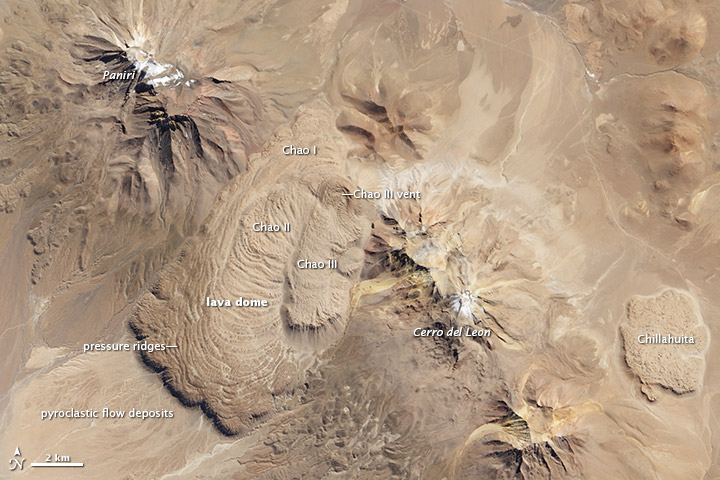Streams of molten rock that ooze from gaps or vents in the Earth’s surface are called lava flows.
Though generally slow-moving, these rivers of rock pose a hazard to
everything in their paths. They can bury or burn homes and roads, ruin
farmland for generations, and transform glaciers into muddy landslides
(lahars).
Lava flows can take many shapes and move at very different rates
depending on the viscosity of the magma, the slope of the land, and the
rate of an eruption. Some of the speediest flows travel 60 kilometers
(40 miles) per hour; the slowest creep along at less than 1 kilometer
(0.6 miles) per hour. They can sometimes even flow for more than a year after an eruption has ended.
Viscous (or sticky), non-explosive flows produce distinctive landforms known as lava domes.
These circular mounds form as lava slowly oozes from a vent and piles
up on itself over time. Lava domes tend to have steep, cliff-like fronts
at their leading edge and wrinkle-like pressure ridges on their
surfaces.
The Chao dacite is a type of lava dome known as a coulée. These elongated flow structures form when highly-viscous lavas flow onto steep surfaces. On May 14, 2013, the Operational Land Imager (OLI) on NASA’s Landsat 8 satellite acquired the image above, which highlights some of the distinctive features of a coulée.
The Chao dacite sits between two volcanoes in northern Chile: the
older and partially-eroded Cerro del Leon and the younger Paniri. The
dome itself is a giant tongue of rock that extends southwest from the
vent. Curved pressure ridges known as ogives dominate the surface of the
14 kilometer (9 mile) dome.
Volcanologists think the Chao dacite dome formed over a period of about 100 to 150 years. A pyroclastic flow during the Chao I phase left light-brown deposits of tephra and pumice
at the leading edge of the flow. Pyroclastic flows are avalanche-like
events that bring mixtures of hot gas and semi-sold rocks surging down
the flanks of volcanoes at speeds as fast as 100 kilometers (60 miles)
per hour.
This period was followed by the Chao II phase, when 22.5 cubic
kilometers (5.4 cubic miles) of lava erupted. This flow has 400-meter
tall (1,312 feet) fronts that stand out with their dark shadows on the
southwest end. The final, Chao III phase added another 3.5 cubic
kilometers (0.8 cubic miles) of denser lava with a lower viscosity. This
type of lava is less likely to form pressure ridges, so surfaces in
this part of the flow are comparatively smooth.
It’s not clear why the Chao dacite erupted as a flow and formed a dome rather than erupting explosively. However, some researchers have noted
that there are a number of other domes in the area (such as
Chillahuita), suggesting that the domes may be the leading edge of a
broader magmatic system that erupted along pre-existing faults. Though
much larger, a series of lava domes along the eastern side of
California’s Sierra Nevada range—the Mono-Inyo chain—offers a possible analog for what might be happening in this part of Chile.
Read part 2 of this story to learn about landforms produced by less viscous lava.
References
- De Silva, S. et al. (2012, September 20) Effusive silicic volcanism in the Central Andes: The Chao dacite and other young lavas of the Altiplano-Puna Volcanic Complex. Journal of Geophysical Research, 99 (9), 17805–17825.
- Oregon State Chao. Accessed November 20, 2013.
- U.S. Geological Survey Lava Flows and their Effects. Accessed November 20, 2013.
- Volcano World How fast does lava flow? Accessed November 20, 2013.
- Wired Eruptions blog. Accessed November 20, 20013.
NASA Earth Observatory images by Robert Simmon, using Landsat 8 data from the USGS Earth Explorer. Caption by Erik Klemetti (Denison University) and Adam Voiland (Earth Observatory).
- Instrument:
- Landsat 8 - OLI
NASA: The Shapes that Lavas Take - Part 1 - Chile - 12.06.13
Ricardo M Marcenaro - Facebook
Blogs of The Solitary Dog:
solitary dog sculptor:
http://byricardomarcenaro.blogspot.com
Solitary Dog Sculptor I:
http://byricardomarcenaroi.blogspot.com
Para:
comunicarse conmigo,
enviar materiales para publicar,
propuestas:
marcenaroescultor@gmail.com
For:
contact me,
submit materials for publication,
proposals:
marcenaroescultor@gmail.com
My blogs are an open house to all cultures, religions and countries. Be a follower if you like it, with this action you are building a new culture of tolerance, open mind and heart for peace, love and human respect.
Thanks :)
Mis blogs son una casa abierta a todas las culturas, religiones y países. Se un seguidor si quieres, con esta acción usted está construyendo una nueva cultura de la tolerancia, la mente y el corazón abiertos para la paz, el amor y el respeto humano.
Gracias :)


No hay comentarios:
Publicar un comentario